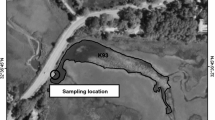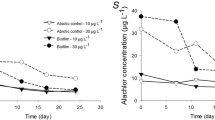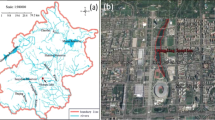Abstract
A multispecies toxicity test system using naturally derived microbial communities on polyurethane foam substrates was used to evaluate the toxic effects of the herbicide atrazine. Both structural (e.g., protozoan species number, biomass) and functional (e.g., colonization rate, oxygen production) community responses were measured. Oxygen production and the ability of communities to sequester magnesium and calcium were the most sensitive measures of toxic stress due to atrazine (maximum allowable toxicant concentrations [MATCs]=17.9 μg/L). Dissolved oxygen was 33% lower, and there was 15% less calcium and magnesium in communities at and above 32.0 μg/L atrazine compared to controls. Species richness and estimates of biomass (total protein and chlorophyll a) were less sensitive (MATCs=193) to atrazine. At the highest atrazine concentration (337 μg/L), species numbers were 30% lower than controls, and protein and chlorophyll a content of communities were reduced by 38 and 91%, respectively. Low levels of atrazine (3.2–32.0 μg/L) resulted in a 46% increase in species numbers and a greater concentration of total protein and chlorophyll a (41 and 57%, respectively). Results compared well with other estimates of chronic toxicity for effects of atrazine on aquatic communities. Reported MATCs ranged from 70.7 to 3,400 μg/L. The results from this test emphasize the importance of monitoring both structural and functional measures of community integrity in toxicity testing with multispecies.
Similar content being viewed by others
References
Albanis TA, Pomonis PJ, Sdoukos AT (1986) Seasonal fluctuations of organochlorine and triazine pesticides in the aquatic system of Ioannina basin (Greece). Sci Total Environ 58:243–253
American Public Health Association, American Water Works Association, Water Pollution Control Federation (1985) Standard Methods for the Examination of Water and Waste-water, 16th edn. Washington DC
Bradford MM (1976) A rapid and sensitive method for the quantitation of microgram quantities of protein, utilizing the principle of protein-dye binding. Anal Biochem 72:248–254
Brockway DL, Smith PD, Stancil FE (1984) Fate and effects of atrazine in small aquatic microcosms. Bull Environ Contam Toxicol 32:345–353
Cairns J Jr (1983) Are single species tests alone adequate for estimating environmental hazard? Hydrobiologia 100:47–57
Cairns J Jr, Kuhn DL, Plafkin JL (1979) Protozoan colonization of artificial substrates. In: Weitzel RL (ed) Methods and Measurements of Periphyton Communities: A Review. American Society for Testing and Materials, Philadelphia PA, pp 34–57
Cairns J Jr, Pratt JR, Niederlehner BR (1985) A provisional multispecies toxicity test, using indigenous organisms. J Test Eval 13:316–319
Cairns J Jr, Pratt JR, Niederlehner BR, McCormick PV (1986) A simple cost-effective multispecies toxicity test, using organisms with a cosmopolitan distribution. Environ Monit Assess 6:207–220
Council on Environmental Quality (CEQ) (1984) Environmental Quality, 15th Report. Washington DC
de Noyelles F Jr, Kettle, WD, Sinn DE (1982) The responses of plankton communities in experimental ponds to atrazine, the most heavily used pesticide in the United States. Ecology 63:1285–1293
de Noyelles F Jr, Kettle WD (1985) Experimental ponds for evaluating the bioassay predictions. In: Boyle TP (ed) Validation and Predictability of Laboratory Methods for the Assessment of Fate and Effects of Environmental Contaminants in Aquatic Ecosystems, STP 865. American Society for Testing and Materials, Philadelphia PA, pp 91–103
Draper NR, Smith H (1981) Applied Regression Analysis. Wiley, New York
Fedtke C (1982) Biochemistry and Physiology of Herbicide Action. Springer-Verlag, New York
Helwig J, Council K (1979) SAS User's Guide. SAS Institute Inc, Cary NC
Johnson BT (1986) Potential impact of selected agricultural chemical contaminants on a northern prairie wetland: A microcosm evaluation. Environ Toxicol Chem 5:473–485
Jones TW, Kemp WM, Stevenson JC, Means JC (1982) Degradation of atrazine in estuarine water/sediment systems and soils. J Environ Qual 11:632–638
Jones TW, Kemp WM, Estes PS, Stevenson JC (1986) Atrazine uptake, photosynthetic inhibition, and short-term recovery for the submersed vascular plant,Potamogeton perfoliatus L. Arch Environ Contam Toxicol 15:277–283
Kemp WM, Boynton WR, Cunningham JJ, Stevenson JC, Jones TW, Means JC (1985) Effects of atrazine and linuron on photosynthesis and growth of the macrophytesPotamogeton perfoliatus L. andMyriophyllum spicatum L. in an estuarine environment. Mar Environ Res 16:255–280
Kleinbaum D, Kupper L (1978) Applied Regression Analysis and Other Multivariable Methods. Duxbury Press, North Scituate MA
Kuemmerlin R (1986) Interactions between the sorption of the herbicide atrazine and the physiological condition of planktonic algae. Arch Hydrobiol Suppl 66:495–571
Larsen DP, de Noyelles F, Stay F, Shiroyama T (1986) Comparisons of single-species, microcosm and experimental pond response to atrazine exposure. Environ Toxicol Chem 5:179–190
MacArthur RH, Wilson EO (1967) The Theory of Island Biogeography. Princeton University Press, Princeton NJ, 203 PP
Macek KJ (1976) Chronic Toxicity of Atrazine to Selected Aquatic Invertebrates and Fishes. US Environmental Protection Agency Ecological Research Series, EPA-600/3-76-047
Malanchuk JL, Kollig HP (1985) Effects of atrazine on aquatic ecosystems: A physical and mathematical modeling assessment. In: Boyle TP (ed) Validation and Predictability of Laboratory Methods for Assessing the Fate and Effects of Contaminants in Aquatic Ecosystems, STP 865. American Society for Testing and Materials, Philadelphia PA, pp 204–228
McCormick PV, Pratt JR, Cairns J Jr (1986) Effect of 3-trifluoromethyl-4-nitrophenol on the structure and function of protozoan communities established on artificial substrates. In: Cairns J Jr (ed) Community Toxicity Testing, STP 920. American Society for Testing and Materials, Philadelphia PA, pp 224–240
Meier RL (1972) Communication stress. Ann Rev Ecol Syst 3:289–314
Moreland DE (1980) Mechanisms of action of herbicides. Annu Rev Plant Physiol 31:597–638
National Research Council (1981) Testing for Effects of Chemicals on Ecosystems. National Academy Press, Washington DC
Niederlehner BR, Pratt JR, Buikema AL Jr, Cairns J Jr (1985) Laboratory tests evaluating the effects of cadmium on fresh-water protozoan communities. Environ Toxicol Chem 4:155–165
— (1986) Comparison of estimates of hazard derived at0 three levels of complexity. In: Cairns J Jr (ed) Community Toxicity Testing, STP 920. American Society for Testing and Materials, Philadelphia Pa, pp 30–48
Odum EP, Finn JT, Franz EH (1979) Perturbation theory and the subsidy-stress gradient. BioScience 29:349–352
Pratt JR, Cairns J Jr (1985) Long-term patterns of protozoan colonization in Douglas Lake, Michigan. J Protozool 32:95–99
Pratt JR, Bowers NJ, Niederlehner BR, Cairns J Jr (In press a) Effect of chlorine on microbial communities in naturally derived microcosms. Environ Toxicol Chem
Pratt JR, Niederlehner BR, Bowers NB, Cairns J Jr (in press b) Prediction of permissible concentrations of copper from microcosm toxicity tests. Tox Assess
Rausch P (1981) The estimation of microalgae protein content and its meaning to the evaluation of algal biomass, V: Comparison of methods for extracting protein. Hydrobiologia 78:237–251
Richard F, Ripley BD, Braun HE, Clegg BS, Johnston R, O'Neill TJ (1987) Survey of farm wells for pesticide residues: Southern Ontario, Canada. Arch Environ Contam Toxicol 16:1–8
Rocchio PM, Malanchuk JL (1986) The effects of atrazine on dissolved oxygen and nitrate concentrations in aquatic systems. Environ Int 12:597–602
Shaw DR, Peiper TF, Nofziger DL (1985) Comparison of chlorophyll fluorescence and fresh weight as herbicide bioassay techniques. Weed Sci 33:29–33
Shen Y-F, Buikema AL Jr, Yongue WH Jr, Pratt JR, Cairns J Jr (1986) Use of protozoan communities to predict environmental effects of pollutants. J Protozool 33:146–151
Sokal RR, Rohlf FJ (1983) Biometry. WH Freeman, NY, 859 pp
Stay FS, Larsen DP, Kato A, Rohm CM (1985) Effects of atrazine on community level responses in Taub microcosms. In: Boyle TP (ed) Validation and Prediction of Laboratory Methods for Assessing the Fate and Effect of Contaminants in Aquatic Ecosystems, STP 865. American Society for Testing and Materials, Philadelphia PA, pp 75–90
Steinheimer TR, Brooks MG (1984) Development and evaluation of a gas chromatgraphic method for the determination of triazine herbicides in natural water samples. Int J Environ Anal Chem 17:97–111
United States Environmental Protection Agency (1985) Methods for the Chemical Analysis of Water and Wastewater, EPA600/4-79-020. National Technical Information Service, Springfield VA
Ward GS, Ballantine L (1985) Acute and chronic toxicity of atrazine to estuarine fauna. Estuaries 8:22–27
Author information
Authors and Affiliations
Rights and permissions
About this article
Cite this article
Pratt, J.R., Bowers, N.J., Niederlehner, B.R. et al. Effects of atrazine on freshwater microbial communities. Arch. Environ. Contam. Toxicol. 17, 449–457 (1988). https://doi.org/10.1007/BF01055510
Received:
Revised:
Issue Date:
DOI: https://doi.org/10.1007/BF01055510




